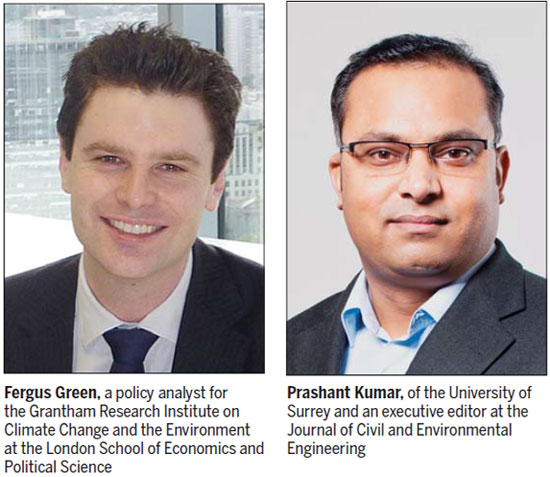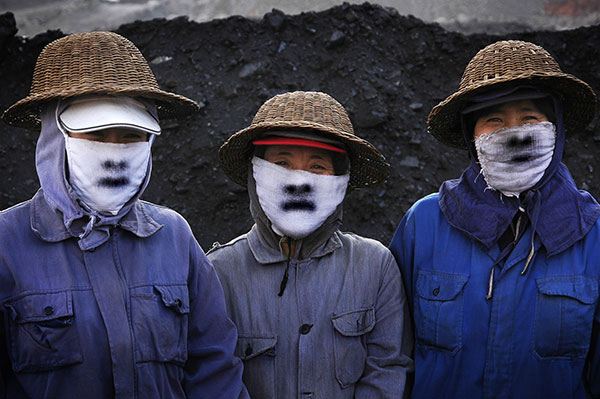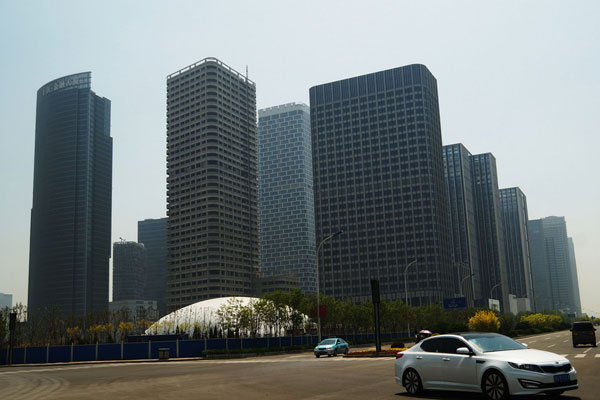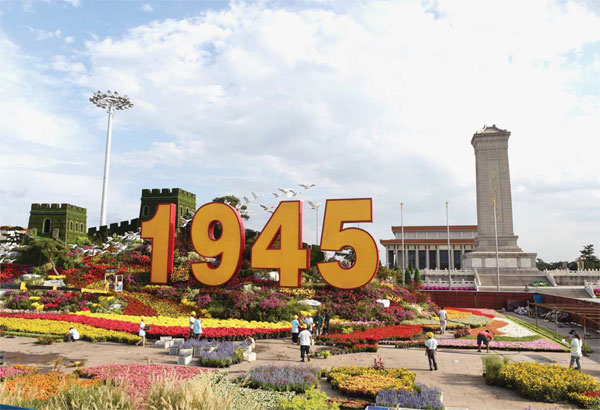Blue skies over Beijing ... for now
Updated: 2015-09-05 07:44
By Wang Mingjie(China Daily Europe)
|
|||||||||||
Measures may keep smog at bay for a while, but experts want long-term strategy
Seeing a blue sky in Beijing has been regarded as luxury in recent years because of air pollution, but in the past few months the smog has largely disappeared from the Chinese capital.
The good weather has been dubbed "parade blue" as a result of the suspension of factories and construction sites in neighboring areas, as well as vehicle restrictions in the capital, in an effort to ensure clear skies for the big military parade that took place on Sept 3.
|
Workers decorate Beijing streets to welcome the military parade on Sept 3. Luo Xiaoguang / Xinhua |

The parade, which took place on Sept 3, was the first staged by China to commemorate the end of World War II, this year being the 70th anniversary of V Day.
The authorities similarly closed factories in November before a meeting in the city of Asia-Pacific leaders, resulting in a period of weather dubbed "APEC blue".
Data from the city's environmental protection bureau show the average level of PM2.5 - harmful fine particulate matter - was 19.5 micrograms per cubic meter between Aug 21 and Aug 25.
Long-term exposure to PM2.5, airborne particles smaller than 2.5 micrometers that can penetrate the lungs, can result in cancer, heart disease, strokes and lung disease, according to the World Health Organization.
"Temporary measures can be effective at reducing pollution but are blunt instruments that can produce very high economic costs," says Fergus Green, a policy analyst for the Grantham Research Institute on Climate Change and the Environment at the London School of Economics and Political Science.
"They are no substitute for a comprehensive strategy and set of policies for reducing pollution and greenhouse gas emissions in the transport sector."
In Beijing, as in other cities, vehicles are the biggest source of pollution, contributing almost a quarter of the total PM2.5 emissions, followed by coal burning.
In the three months to June, the capital topped a list of 45 major Chinese cities for traffic congestion, with the frequent use of ride-hailing services a major factor, according to AutoNavi Software Co, a mobile Web mapping and navigation service.
Effectively tackling pollution while maintaining sustainable economic growth has become a headache for the Beijing municipal government.
Green estimates that if the existing economic and policy trends continue, China's greenhouse gas emissions are likely to peak by 2025, perhaps even earlier.
"Many sectors in China's economy are experiencing serious problems with overcapacity, particularly in construction, heavy industries such as steel, cement and aluminum, and coal-fired power generation," he says.
"Further investment in these sectors would be inefficient and hinder economic growth over the medium term.
"The key to future sustainable growth in China is a shift toward increasing domestic household consumption, especially of services, and a reallocation of capital investment toward services and innovative, higher value-added manufacturing industries such as renewable energy and energy-efficient technologies."
To reduce demand for private vehicles, he suggests the government considers "compact city" planning measures based on high-density areas linked by efficient and affordable public transport, and pedestrian and cycling infrastructure, such as bike-sharing projects and bike lanes.
Green also proposes imposing a congestion charge, a means of taxing private vehicle use during peak times, as is done in London and Singapore.
At the national level, he says, long-term policy support for innovation in low-carbon, low-pollution energy and transport technologies should be encouraged.
Air pollution is an issue in many Asian cities, and Beijing is not the only megacity that finds it difficult to keep the skies blue.
Prashant Kumar, of the University of Surrey and an executive editor at the Journal of Civil and Environmental Engineering, cites New Delhi, where vehicles are also a major source of pollution despite public transport running on relatively clean compressed natural gas.
Controlling emissions at the source will reduce them, but simply placing a blanket ban on cars is not sustainable for a city, he says, so instead better fuel quality and vehicle technology should be used.
"A key aspect is to use cleaner diesel - for example, in Europe they use ultra-sulfur diesel. Lowering the quantity of sulfur in diesel helps to cut emissions of sulfur dioxide, which is a precursor gas for tiny nanoparticles," Kumar says.
During a visit to France in June, Premier Li Keqiang announced plans to cut China's carbon emissions per unit of gross domestic product by 60 to 65 percent compared with 2005 levels. The move was part of a plan submitted to the United Nations before the Paris climate change talks in December.
"China's contribution to the international climate conference in Paris is very constructive and indicates the importance with which the Chinese leadership views this conference and the issue of climate change," Green says. "The European Union and its member states can and should work closely with China to address the shared challenges of climate change, resource and energy security, and environmental pollution and degradation."
In particular, he says, the two sides should collaborate in the areas of clean technology innovation such as offshore wind farms, advanced solar technologies, battery storage, smart electricity grid infrastructure, and green financial institutions and mechanisms.
Green also urges both parties to look into "developing fiscal policies and measures to discourage high-carbon and environmentally destructive energy sources and technologies, including phasing out direct subsidies for fossil fuels and electricity; introducing resource taxes on coal and other fossil fuel resources; introducing local taxes and charges on congestion, landfill and other polluting activities; and encouraging low- or zero-carbon energy sources and technologies".
wangmingjie@mail.chinadailyuk.com
(China Daily European Weekly 09/05/2015 page14)
Today's Top News
Drowned Syrian boys buried in home town
Britain to accept more Syrian refugees
US blogger: The parade shows President Xi is a true world class leader
China deserves more recognition for its contributions in WWII: scholar
Intl community echoes Xi's speech at V-Day commemoration
Sino-Russian investment fund eyes more deals
His name was Aylan, or humanity washed ashore: Opinion
Predicting Internet's future without a crystal ball
Hot Topics
Lunar probe , China growth forecasts, Emission rules get tougher, China seen through 'colored lens', International board,
Editor's Picks

|

|

|

|

|

|







